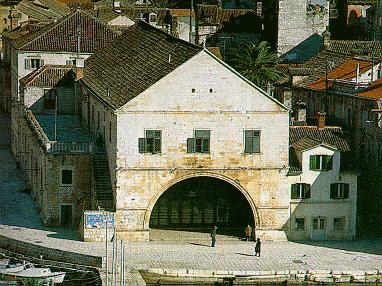

The very early building of the shore facilities and the arsenal was determined by the exceptionally suitable maritime character of the port of Hvar.
The building of the arsenal was started in the 13th century as a warehouse for the communal war galley. It was damaged by the Turkish ravages of 1571 and by gun-powder explosion in the Hvar fortress in 1579; and finally achieved its present-day appearance in the 17th century. Beside the arsenal a Fontic was built; it was warehous for the municipal supply of wheat and salt. Its facade is embellished with arched portals.
In 1612 a theatre was built on the first floor of the arsenal. It is one of the oldest in Europe and certainly the first municipal one as well. Built by the efforts and contributions of all the members of the community, regardless of class, it shows the high cultural standards set by this, in European relations small and rather isolated society.
Near the arsenal, there is a small enclosed marina "Mandrac" (from the Greek word mandra=sheepfold), which closes the west side of the square, and is mentioned for the first time in 1459. In 1795 the Venetian District Governor Marco Dandalo finished the building of Mandrac by putting Baroque pyramids on the walls around it.
The stone paved quay, called Fabrika, dating from 1554, stretches from the north-west of Mandrac. This quay, one of the oldest in Europe, was built from monumental stone blocks interconnected by stone grooves. The City Walls from the end of the 13th century, stretch from the city fortress towards the square where they join the third wall in an east-west direction. This wall is practically camouflaged by a series of patrician houses built into it. The City Walls are interspersed with four-cornered side towers, the construction of which lasted, with essential repairs, from the 13th to the 16th century.
The main city gate (Porta del datolo), leads to the foot of the square, while
the east one is in the vicinity of the cathedral, and newer, dating from 1454.